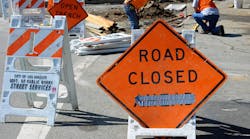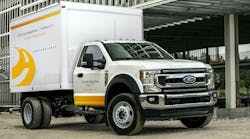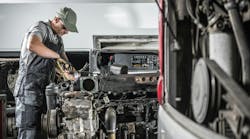If you’re operating trucks on major urban-area roadways — highways, freeways and arterial routes that see more than half of the nation’s 3 trillion total miles driven annually — expect that drivers will encounter more bumps that could jack up maintenance, fuel and other costs. Less than one-third of those major roadways are now rated in good condition, according to a report released July 23, while 28% are rated poor or substandard; the rest fall somewhere in between.
The report comes from TRIP, a national transportation research group based in Washington, D.C. The organization notes that local and state governments can’t keep up with needed roadway repair and repaving costs, and says a solid federal funding commitment is needed to get these roads in shape to handle current and increasing volume demands.
“This is no surprise for those of us who live in urban areas and face this every day, hitting potholes and getting stuck in traffic,” said Jill Ingrassia, managing director of government relations and traffic safety advocacy at AAA, during a conference call to discuss the report.
The nationally aggregated percentages don’t do much to illustrate how serious the situation is in many cases. In large urban areas with populations of 500,000 or greater, for example, the San Francisco-Oakland, Calif. area ranked worst with nearly three-quarters of major roadways in poor condition, according to the report.
California has more large urban areas with the highest percentages of poor-condition major roadways than any other state. Behind San Francisco-Oakland are the Los Angeles-Long Beach-Santa Ana (73%), Concord (62%), San Jose (53%), San Diego (51%), and Riverside-San Bernardino (46%) areas. The rest of the top 25 large urban regions with the highest percentages of poor-condition major roads are found in Michigan, Ohio, New York, Hawaii, Texas, Wisconsin, Oklahoma, Connecticut, Alabama, Colorado, Washington, Nebraska and Louisiana.
Meanwhile, among smaller urban areas with populations between 250,000 and 500,000, the worst is Flint, Mich., with 54% of major roadways in poor condition. Among others in the top — or rather, bottom — 10 smaller urban regions, California again factored most prominently with three entries, while Trenton, N.J.; Scranton, Penn.; Reno, Nev.; Spokane, Wash.; Jackson, Miss.; and Lansing, Mich. also are listed as areas with the most major roads in rough shape.
“In California, their challenge is many of their roads are some of the most heavily traveled in the country,” said Rocky Moretti, director of research and policy at TRIP. By contrast, other Sun Belt states such as South Carolina and Georgia don’t have that volume — or the harsher winters the more northern states have, another factor in road wear — and have lower percentages of major roads in disrepair, the report shows.
“While those California roads can be maintained,” Moretti noted, “it takes very high levels of investment.”
Maintenance costs higher
The report didn’t have specific costs for heavy duty or commercial vehicles, but deteriorated roadways have been contributing more to the marginal costs of operating a commercial truck fleet in a variety of ways. Those include higher maintenance and repair costs due to road-induced damage, time lost to traffic backups, greater fuel consumption and more.
According to the American Transportation Research Institute’s latest analysis of the operational costs of trucking, maintenance and repairs have been growing as a portion of overall marginal costs. In 2008, maintenance and repairs made up an average of 6% of motor carriers’ total marginal costs, and in 2013 the figure was 9%, according to the research group. Repairs and maintenance added an average of $0.103 per mile to motor carriers’ costs in 2008 and $0.148 in 2013.
Not only do they contribute to “wear and tear” and other costs for commercial and passenger vehicles, but poor-condition roads also cost the most to fix, TRIP points out. When a road becomes badly deteriorated, it has to be reconstructed, involving a complete milling and repaving. TRIP calls for roads to be properly repaired — reconstructed in some cases with heavier-duty materials to handle changing traffic needs — and systematically maintained in the following years.
“A properly implemented pavement preservation approach to keeping pavements in good condition has been found to reduce overall pavement life cycle costs by approximately one-third over a 25-year period,” the report states. “Roads that have significant deterioration must be maintained with surface repairs until sufficient funds are available to reconstruct [them], at which time a pavement preservation strategy can be adopted.”
Moretti emphasized these points on the call. “The further you fall behind, the more difficult it is to make improvements,” he said. “It’s an argument for making longer-lasting repairs — patches are not long-term solutions.”
Notably, the report’s findings can’t tell the whole story as roadways truly exist today. TRIP’s study is based on the Federal Highway Administration’s 2013 national data, the latest available, but a lot can happen with roads in two years’ time — particularly following consecutive winters that had extended periods of deep cold and sustained snow plowing, both of which are significant contributors to road deterioration, in many regions.
In addition, roadway repairs got a boost in recent years from economic stimulus funds that ran out in 2013, Moretti said, so those funds haven’t been a factor since.
More volume, heavier-duty needs
With many roadways in need of TLC, passenger car and commercial traffic volume both are on the rise following a five-year period from 2008 to 2013 — the years the so-called Great Recession was most pronounced — when vehicle traffic stayed about flat. And while overall traffic volume is rising and is projected to continue to do so, heavy truck traffic stands to increase at a markedly faster rate than that of passenger cars, according to the report, and roadway rebuilding and repair needs to take that into consideration.
From 1990 to 2013, travel by large commercial trucks increased by 79%, according to the report, and is projected to increase by another 72% from now through 2030. That works out to a nearly 5% increase each year vs. commercial truck miles currently logged.
More heavy trucks on the road has become a factor not only on highways and freeways but on the broad range of arterial roadways, which Moretti noted are “really the roads that people are driving on once they’ve left their neighborhoods.” Many such roads are maintained by local rather than state governments, and municipalities — even within the same county — often differ in their approach to fixes.
The report calls for roads to be repaired and maintained with heavier-duty materials to reduce costs in the long run and help handle greater commercial traffic needs. Even rural areas have seen increases in industrial vehicle travel for things like agriculture and energy extraction, Moretti noted, putting greater demands on roads.
“It’s a challenge,” he said, adding that local governments also have been adjusting their approaches by considering elements like materials used, thickness and substructures of roads. “The economic trends are creating the need for increased movement in goods,” Moretti contended.
Meanwhile, the increasing overall traffic volume — while good in the sense that it’s an indication the economy is improving — also compounds the problem of getting roadways in better shape, since more traffic makes repairs more difficult to manage and contributes to roadway deterioration.
Investments needed
So what’s it going to take to get the nation’s roadways up to snuff? The report cites data from the American Association of State Highway and Transportation Officials placing the current backlog of road, highway and bridge repairs at about $740 billion. That breaks down to $392 billion for roads and highway repairs, $237 billion to add needed highway lanes and $112 billion for bridge rehabilitation.
Further, maintaining the roadways in good repair from that point is estimated to cost about $120 billion annually, which assumes a vehicle traffic increase of one percent each year. But traffic growth might exceed that rate, which correspondingly would add to funding needs. For instance, an overall vehicle traffic increase of 1.4% each year would raise maintenance costs to $144 billion, or 1.6% would require an annual investment of $156 billion, according to the report.
Annual surface transportation spending now is about $88 billion, the report notes. While TRIP researchers contend more federal investment is needed, Moretti noted that states and localities have increasingly been recognizing the need for roadway and infrastructure improvement. “When we look at a variety of transportation referendums, they generally have been faring well at the local and state levels,” he said.
Greater funding has to come from somewhere, and a tax increase of some kind to fund necessary investments is likely to be a political “third rail” with the election season approaching. But Moretti pointed out that the cost of a tax increase pales in comparison to the cost of doing nothing. “We would hope that as [taxpayers] look at this, they realize driving on smoother roads is going to cost a lot less money,” he said.
The TRIP report is available at www.tripnet.org.



